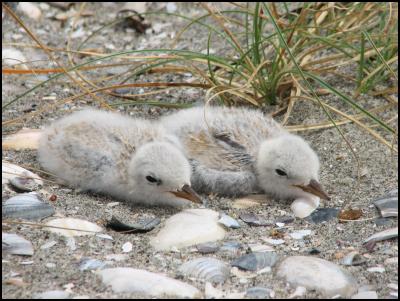Coastal development threatens rare birds
28 April 2006
Coastal development threatens
rare birds

New Zealand fairy terns may be the most critically endangered bird in New Zealand, and perhaps even the world’s rarest tern, new DNA evidence suggests.
Research by Auckland University that suggests New Zealand fairy terns have unique DNA characteristics heightens concerns that a proposed subdivision of up to 2000 houses near Mangawhai Heads poses a serious threat to the terns’survival.
Forest & Bird North Island Field Coordinator David Pattemore said promises by developers that cats would be banned and dogs restricted to leashes, while well-intentioned, were not enough to protect the terns from predation.
It would be impossible to enforce the restrictions on pets in such a large settlement and, given the terns’ critically low numbers - just 10 breeding pairs remaining - just one cat or dog could do enough harm to condemn the birds to extinction, Mr Pattemore said.
The genetic research by Auckland University confirms unique genetic features among the New Zealand fairy terns, which shows they comprise a distinct population, with characteristics different from Australian and New Caledonian populations of fairy tern, and do not breed at all with their overseas relations.
With just 35 birds left, the New Zealand fairy terns are New Zealand’s most critically endangered bird – with less than half the numbers of the iconic kakapo (of which there are 86).
Further research may confirm the New Zealand fairy tern as an entirely separate species, which could earn it the dubious honour of being the world’s most endangered tern species, overtaking the Chinese crested-tern, which has a similarly low population below 50.
ENDS


 Gordon Campbell: On The Government’s Latest Ferries Scam
Gordon Campbell: On The Government’s Latest Ferries Scam Diane McCarthy - LDR: War Hero Willie Apiata Entrusts MP With Victoria Cross Medal
Diane McCarthy - LDR: War Hero Willie Apiata Entrusts MP With Victoria Cross Medal PSA: Disappointing Govt Attack On Diversity, Inclusion In Public Service
PSA: Disappointing Govt Attack On Diversity, Inclusion In Public Service NZ Labour Party: Govt Health And Safety Changes Put Workers At Risk
NZ Labour Party: Govt Health And Safety Changes Put Workers At Risk Amnesty International Aotearoa New Zealand: Democracy At Risk
Amnesty International Aotearoa New Zealand: Democracy At Risk Walk Without Fear Trust: New Sentencing Reforms Aimed At Restoring Public Safety Welcomed
Walk Without Fear Trust: New Sentencing Reforms Aimed At Restoring Public Safety Welcomed Rio Tinto & NZAS: Archaeological Project Underway From Historic Excavations At Tiwai Point
Rio Tinto & NZAS: Archaeological Project Underway From Historic Excavations At Tiwai Point


